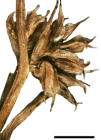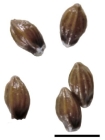WoRMS taxon details
Diplacrum blakei K.L.Wilson & R.L.Barrett
1751560 (urn:lsid:marinespecies.org:taxname:1751560)
accepted
Species
recent only
Wilson, K. L.; Barrett, R. L. (2023). Revision of the tropical genus Diplacrum (Cyperaceae: Bisboeckelereae) in Australia. <em>Australian Systematic Botany.</em> 36(2): 143-156., available online at https://www.publish.csiro.au/SB/SB22028 [details] Available for editors  [request]
[request]
Holotype NSW 2314184, geounit Kimberley
Holotype NSW 2314184, geounit Kimberley [details]
Description Nutlets narrow–ellipsoid to narrow–obovoid, with 3 main longitudinal ribs and 3–5 longitudinal ridges between them...
Distribution In tropical Queensland, Northern Territory and Western Australia
Description Nutlets narrow–ellipsoid to narrow–obovoid, with 3 main longitudinal ribs and 3–5 longitudinal ridges between them (not all complete, often more slender and slightly paler in colour), glabrous, glossy; female glumes 1.4–1.8 mm long, including excurved awn 0.4–0.7 mm long; leaves often much exceeding the inflorescence (up to ~2.5 times as long). Dwarf herbaceous annual, glabrous, 1–6 cm high, with reddish fibrous roots. Culms tufted, more or less erect or spreading. Leaves longer than inflorescences (up to ~2.5 times as long); leaf blades flat, glabrous, margins with sparse, minute, antrorsely aculeate prickle hairs towards apex, 0.3–0.7 mm wide at mid-length, with mid-nerve and 2 lateral nerves prominent on both adaxial and abaxial surfaces; no ligule or contraligule (top of leaf sheath opposite the junction with the blade truncate, not thickened); sheaths green turning straw-coloured with age, occasionally with reddish tinges. Inflorescence approximately the same length as or longer than the culms, composed of several (3 or 4) axillary clusters of spikelets more or less adjacent because of short internodes or occasionally the internodes to 5 mm long and the clusters more distant; each cluster usually with 1 or 2 basal male spikelets and an upper female spikelet. Involucral bract at each node leaf-like, usually much longer than inflorescence. Male spikelets 0.5–0.7 mm long, with 1 slender, more or less hyaline glume 0.5–0.7 mm long, not or scarcely indurated at maturity and reddish- brown; stamen 1; anther 0.2–0.3 mm long, with apical appendage <0.1 mm long. Female spikelets 1.3–1.8 mm long, with 2 glumes encircling the ovary but not tightly clasping the nutlet; peduncle somewhat thickened at apex but rarely cup-like (much less obvious than in D. pygmaeum); glumes narrow–elliptical with apex broad–acute to obtuse, green becoming straw-coloured with age, with scattered minute red dots, with narrow hyaline margins, 1.4–1.8 mm long including excurved awn 0.4–0.7 mm long, nearly as long as the body of the glume, strongly 3-nerved. Disc triquetrous, white, slightly enlarged at the 3 corners, coinciding with the white thickened base of the 3 ribs of the nutlet, adhering to nutlet. Style 3-fid. Nutlet narrow–ellipsoid to narrow–obovoid, trigonous in cross- section, with 3 main longitudinal ribs and 3–5 longitudinal ridges between them (not all complete, often more slender and slightly paler in colour), glabrous, glossy, dark purplish brown at maturity, 0.4–0.7 mm long, 0.3–0.4 mm in diameter [details]
Distribution In tropical Queensland, Northern Territory and Western Australia
Distribution In tropical Queensland, Northern Territory and Western Australia [details]
Cyperaceae Working Group. (2025). [see How to cite]. Global Cyperaceae Database. Diplacrum blakei K.L.Wilson & R.L.Barrett. Accessed through: World Register of Marine Species at: https://www.marinespecies.org/aphia.php?p=taxdetails&id=1751560 on 2025-03-23
Date
action
by
2024-12-10 11:47:54Z
unchecked
db_admin
![]() The webpage text is licensed under a Creative Commons
Attribution 4.0 License
The webpage text is licensed under a Creative Commons
Attribution 4.0 License
Nomenclature
original description
Wilson, K. L.; Barrett, R. L. (2023). Revision of the tropical genus Diplacrum (Cyperaceae: Bisboeckelereae) in Australia. <em>Australian Systematic Botany.</em> 36(2): 143-156., available online at https://www.publish.csiro.au/SB/SB22028 [details] Available for editors  [request]
[request]
 Present
Present  Present in aphia/obis/gbif/idigbio
Present in aphia/obis/gbif/idigbio  Inaccurate
Inaccurate  Introduced: alien
Introduced: alien  Containing type locality
Containing type locality
Holotype NSW 2314184, geounit Kimberley [details]
From editor or global species database
Description Nutlets narrow–ellipsoid to narrow–obovoid, with 3 main longitudinal ribs and 3–5 longitudinal ridges between them (not all complete, often more slender and slightly paler in colour), glabrous, glossy; female glumes 1.4–1.8 mm long, including excurved awn 0.4–0.7 mm long; leaves often much exceeding the inflorescence (up to ~2.5 times as long). Dwarf herbaceous annual, glabrous, 1–6 cm high, with reddish fibrous roots. Culms tufted, more or less erect or spreading. Leaves longer than inflorescences (up to ~2.5 times as long); leaf blades flat, glabrous, margins with sparse, minute, antrorsely aculeate prickle hairs towards apex, 0.3–0.7 mm wide at mid-length, with mid-nerve and 2 lateral nerves prominent on both adaxial and abaxial surfaces; no ligule or contraligule (top of leaf sheath opposite the junction with the blade truncate, not thickened); sheaths green turning straw-coloured with age, occasionally with reddish tinges. Inflorescence approximately the same length as or longer than the culms, composed of several (3 or 4) axillary clusters of spikelets more or less adjacent because of short internodes or occasionally the internodes to 5 mm long and the clusters more distant; each cluster usually with 1 or 2 basal male spikelets and an upper female spikelet. Involucral bract at each node leaf-like, usually much longer than inflorescence. Male spikelets 0.5–0.7 mm long, with 1 slender, more or less hyaline glume 0.5–0.7 mm long, not or scarcely indurated at maturity and reddish- brown; stamen 1; anther 0.2–0.3 mm long, with apical appendage <0.1 mm long. Female spikelets 1.3–1.8 mm long, with 2 glumes encircling the ovary but not tightly clasping the nutlet; peduncle somewhat thickened at apex but rarely cup-like (much less obvious than in D. pygmaeum); glumes narrow–elliptical with apex broad–acute to obtuse, green becoming straw-coloured with age, with scattered minute red dots, with narrow hyaline margins, 1.4–1.8 mm long including excurved awn 0.4–0.7 mm long, nearly as long as the body of the glume, strongly 3-nerved. Disc triquetrous, white, slightly enlarged at the 3 corners, coinciding with the white thickened base of the 3 ribs of the nutlet, adhering to nutlet. Style 3-fid. Nutlet narrow–ellipsoid to narrow–obovoid, trigonous in cross- section, with 3 main longitudinal ribs and 3–5 longitudinal ridges between them (not all complete, often more slender and slightly paler in colour), glabrous, glossy, dark purplish brown at maturity, 0.4–0.7 mm long, 0.3–0.4 mm in diameter [details]Distribution In tropical Queensland, Northern Territory and Western Australia [details]
Habitat Commonly grows with D. caricinum, D. latzii, D. pygmaeum and other annual sedges on the margins of wet areas (swamps and streams). [details]







